Hi everyone, my name is Tahlia Trevino, and this is the 5th week of my internship at the Miller Lab at UCSB. Just for a refresher, I am interning for marine biology at the lab, and I work on several different projects, getting to learn about the aspects of being a marine biologist.
Monday, July 17th
Today I was able to start late and enjoy the early sunrise! I went to the beach and did a hit of swimming before heading back and going to my internship. Once I arrived at the Miller Lab, I worked on my project where I identify species within an image in different photos taken in different transects to find out what species are living in certain areas in the ocean. Then I assisted a college student in her research on zooplankton, which are very tiny creatures that are crucial to the ocean’s food chain. We looked through microscopes trying to identify the zooplankton, and then we also fed the plankton, which is very intricate. Because of how small they are they have to eat very small pieces of food of bacteria and algae.
Tuesday, July 18th
Today I went to a lecture about the Rocky Intertidal. Which is an area between marine and terrestrial habitats where organisms living within this zone are well adapted to alternating exposures to both the air and sea. Intertidal zones of rocky shorelines host sea stars, snails, seaweed, algae, and crabs. Barnacles, mussels, and kelps can survive in this environment by anchoring themselves to the rocks. Barnacles and mussels can also hold seawater in their closed shells to keep from drying out during low tide. Most of the species living here are very resilient as they endure extreme temperature changes, crashing waves, and human interaction. After the lecture, I went back to the Miller Lab identifying more and more species.
Wednesday, July 19th
Today I started by heading over to the Miller Lab where I worked on my project identifying species. The progress has been great, and so has the evidence. I learn more and more about these different species, like where they live, they’re eating habits, and what they look like. After my day at the internship, I headed to downtown Santa Barbara where I went to State St and walked around downtown. Then I went to Sterns Warf, the main pier in Santa Barbra, and sat down to watch the sunset.
Thursday, July 20th
Today I went to a lecture where I learned about mangroves. Mangroves aren’t very prevalent on the Pacific coast of North America, but there are still a couple. The majority of these groves are on the Atlantic and Indian coasts. Florida is covered in mangroves which provide a tourist attraction. Mangroves are scientifically a woody, tropical halo type that is an obligate inhabitant of the mangal. To clarify what this means, halophytes are plants that grow in high-saline water, and a mangal is a tree in the mangrove. There are different kinds of mangroves, but the most common is the red mangrove. These plants grow in salt water which is not common. They use filtration and salt glands to remove salty water from their roots. They also slowly consume water and have slow photosynthesis to manage the sally intake. The mangroves live in a big community. Some plants compete with the species and animals which pollinate, eat, and live on the plants. Animals such as manatees, fish, bees, and bats thrive off the mangrove areas. There is also a bunch of human interaction with the mangroves. On the coast of India, the Sundarbans are the largest mangrove in the world. People come to tour and visit the mangroves all the time. However, for the people who live here, the mangroves are unforgiving. Humans who go fishing or collecting honey are often eaten by tigers. The tigers have ruled the Sundarbans for centuries, and when humans started to arrive at the mangroves the tigers felt threatened. Mangroves are very important to communities but also an intricate food chain. Later on that day, I went to a lab where we studied creatures in the wrack, which consists of dried kelp, and studied the creatures inside. Wrack serves as the primary source of nutrients to beach communities and is the foundation for the food chain. This lab was done later at night because most creatures on the beach are nocturnal. The wrack consists of beach hoppers, roly polies, kelp flies, and predatory rove beetles. After the lab, we made a campfire on the beach and just talked for a while before heading back.
Friday, July 21st
Today I got up super early to head out to Santa Cruz Island. The island is about an hour’s boat ride away from the harbor in Santa Barbara. We went out there to take pictures of the transects I identify species on. We found such cool creatures while we were diving around. There were huge starfish, urchins, sea lions, dolphins, octopi, and jellyfish. We went to two sites on the island, and it took the whole day. It was cool to see how the people in the lab worked and collected data out in the field. On our way back there were hundreds of dolphins swimming and flipping around so we worked off the side of the boat as we were heading back. We decided to drokel. For those who don’t know what dorkeling is, it is when you just put your mask on and hang off the side of the boat, putting your face into the water, and watching the dolphins swim alongside you. This is a made-up term that the lab workers use. Once I got back to campus I was exhausted.
Saturday, July 22, and Sunday, July 23
On Saturday I went to the beach for almost the whole day and just slept. I was super exhausted from Friday and did not feel like adventuring out. Then later that evening I went to watch the Barbie movie with some of my friends. It was really fun. On Sunday I started packing some of my stuff and did some cleaning in the morning. Then headed to the mall in Goleta just for fun. It was a very chill day which I felt I needed. Overall an awesome and fun week, and I’m excited for my final week!

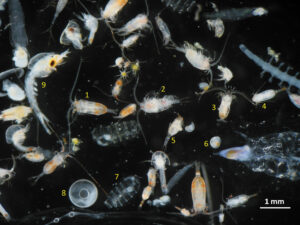
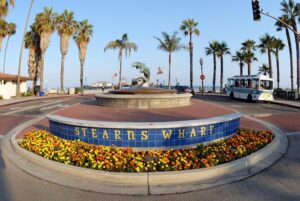
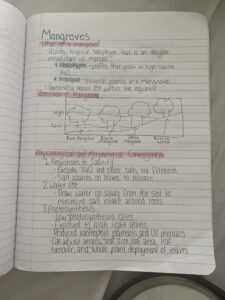
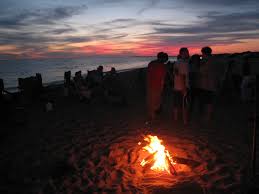
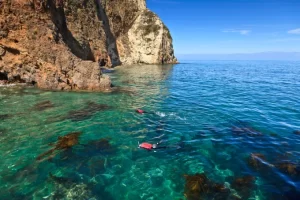
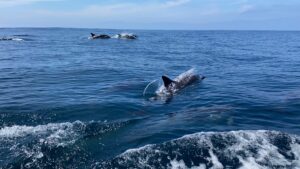
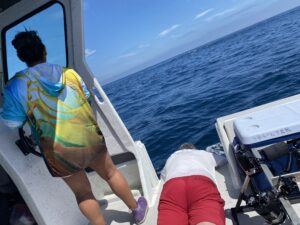
There are no comments published yet.